Animals that start with E include mammals such as elephants, elands, echidnas and the elk; birds such as eagles, eiders, the emu and emperor penguin; insects such as earwigs; reptiles such as the eastern coral snake; and fish such as eels and eagle rays.
On this page is a list including these and many other interesting animals beginning with E, together with pictures and facts on each species.
Below each animal you’ll find links that you can follow for further information, pictures and videos.
Included in this list are individual species (e.g., the eastern mole) and groups of animals (e.g., elephants) whose names begin with E.
The scientific name and conservation status are provided for each of the individual species.
Index

Scroll down to see pictures and facts on all of the animals, or use the index below to go directly to a particular animal.
List Of Animals Beginning With E
- Eagle
- Eagle Ray
- Earthworm
- Earwig
- Eastern Coral Snake
- Eastern Gorilla
- Eastern Mole
- Echidna
- Echinoderm
- Edible Frog
- Eel
- Eider
- Eland
- Electric Eel
- Eleonora’s Falcon
- Elephant
- Elephant Seal
- Elephant Shrew
- Elk
- Emperor Penguin
- Emu
- English Shepherd
- Eskimo Dog
- Ethiopian Wolf
- Eurasian Beaver
- Eurasian Red Squirrel
- Eurasian Wolf
- European Common Frog
- European Grass Snake
You can find animals beginning with other letters by clicking on the squares below…



























Eagle
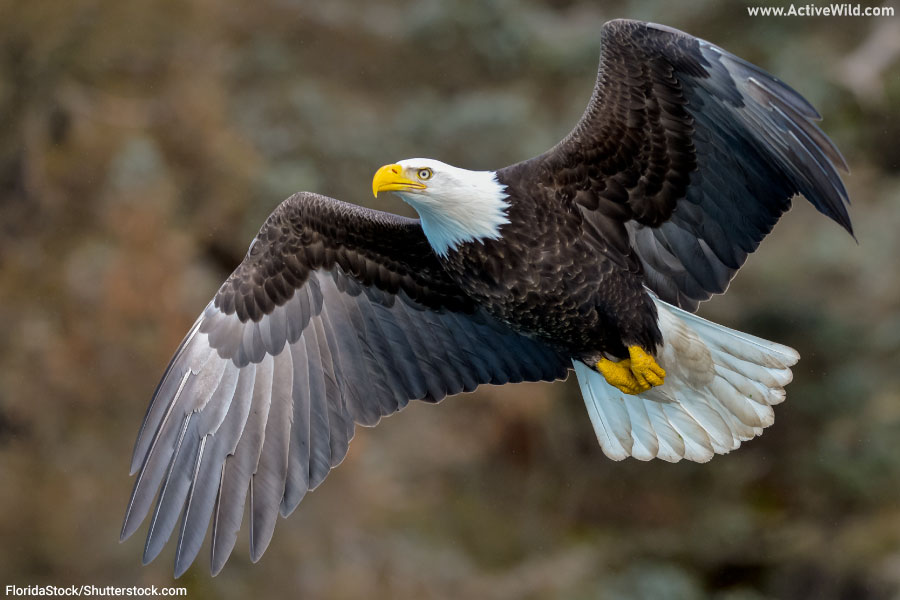
Type of animal: Bird
Family: Accipitridae
Where found: All continents except Antarctica
Eagles are large birds of prey with powerful talons, hooked bills, and eyesight that is among the best in the entire animal kingdom.
There are over 70 species of eagle, and these powerful avian predators are found on every continent except for Antarctica.
The world’s largest eagles are: by weight, Steller’s sea eagle; by body length, the Philippine eagle; and by wingspan, the white-tailed eagle.
Other well-known eagles include the golden eagle (found in upland areas throughout the Northern Hemisphere), the bald eagle (a sea eagle found on the coast and in wetlands in North America) and the harpy eagle (found in tropical rainforests in Central and Southern America).
All eagles are members of the bird family Accipitridae, which is also home to hawks, kites, harriers and old world vultures.
Discover More With Active Wild
You can find out more about birds on this page: Birds - The Ultimate Guide
Discover different types of birds on this page: Types of Birds
Eagle Ray (Common)

Scientific name: Myliobatis aquila
Type of animal: Fish
Family: Myliobatidae
Where found: Atlantic Ocean, Indian Ocean
Conservation status: Critically Endangered
The common eagle ray is one of around 20 species of eagle ray, which together make up the family Myliobatidae.
Eagle rays have wide, flat bodies and long tails. Like all rays, they swim by “flapping” their enlarged, wing-like pectoral (side) fins.
The common eagle ray, an eagle ray found in the eastern Atlantic (including the Mediterranean) and along the African coast of the Indian Ocean, is a critically endangered species. This is due mainly to overfishing.
Rays, along with sharks, skates, sawfish and chimaeras, make up a group of fish known as “cartilaginous fish”.
Whereas the skeletons of most fish are made of bone, those of the cartilaginous fish are made of cartilage. (Cartilage is a hard, but flexible material. Your ears, and the tip of your nose, are made of cartilage.)
Discover More With Active Wild
You can see more ocean animals on this page: Ocean Animals List with Pictures & Facts
Discover more about the world’s oceans on this page: The Marine Biome
Earthworm
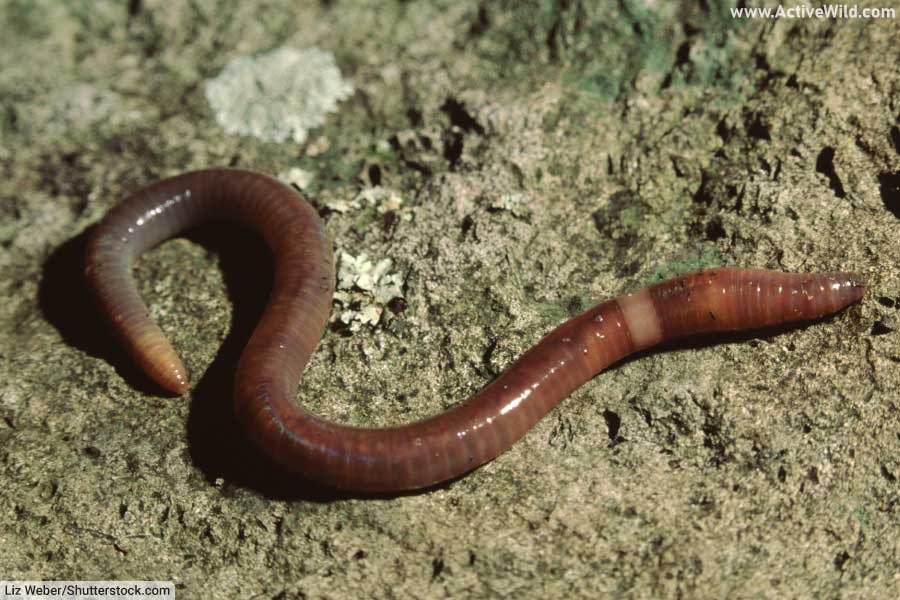
Type of animal: Annelid
Phylum: Annelida
Where found: All continents except Antarctica
Earthworms are long, tubular invertebrates belonging to the order Opisthopora. There are over 6,000 known species of earthworm, and they found on all continents except Antarctica.
Protruding from each segment of an earthworm’s body are small bristles known as setae. An earthworm moves by expanding and contracting its body, with the setae acting as anchors as the worm pushes and pulls. Mucous secreted from the worm’s skin provides lubrication that aids tunnelling.
Earthworms don’t have lungs (they “breathe” through their skin) or eyes (they have light-sensing cells in their skin).
Earthworms are hermaphrodites (their body contains both male and female parts), and some earthworm species are parthenogenic (capable of producing offspring without a partner).
(A searchable database of all earthworm species can be found here.)
Discover More With Active Wild
They may be very different to us, but worms are animals too! Find out why on this page: The Animal Kingdom
Discover more about the different types of animals: Types of Animals
Earwig

Type of animal: Insect
Order: Dermaptera
Where found: All continents except Antarctica
Earwigs are insects belonging to the order Dermaptera. There are around 2,000 species of earwig, and they are found on every continent except Antarctica.
Earwigs are characterized by long, flat bodies and pincers that extend from the abdomen. An earwig’s pincers are used in defense, hunting and courtship. The pincers of male earwigs are usually more curved than those of the female.
Earwigs typically live in nooks and crannies, but contrary to popular belief don’t habitually in the ears of other animals.
Although they are usually seen scurrying along the ground, most species of earwig are able to fly. Like beetles, earwigs fly using their hindwings alone, their forewings having evolved into protective wing cases.
Discover More With Active Wild
You can find out more about insects on this page: Insects - The Ultimate Guide
Discover why insects are animals on this page: Are Insects Animals?
Eastern Coral Snake

Scientific name: Micrurus fulvius
Type of animal: Reptile
Family: Elapidae
Where found: North America
Conservation status: Least Concern
The eastern coral snake is a venomous snake found in the southeastern United States. The species can be identified by its distinctive markings, which consist of wide red and black rings separated by narrow yellow rings. The snake reaches lengths of up to 1.2 m / 4 ft.
Several non-venomous kingsnakes, such as the scarlet kingsnake and Mexican milk snake, have markings similar to those of the eastern coral snake.
The snakes can be told apart by the sequence of ring colors; the red and yellow rings of the venomous coral snake are adjacent to one another; whereas the red and yellow rings of the non-venomous kingsnakes are separated by the black rings.
The venom of the eastern coral snake contains neurotoxins that affect nerve tissue. A bite from the species is potentially fatal without antivenom. However, occurrences of eastern coral snakes biting humans are extremely rare (there are around 100 cases per year). Due to the availability of antivenom, fatalities are virtually unknown.
Discover More With Active Wild
You can find out more about snakes on this page: Snakes
Discover different types of snakes on this page: Types of Snakes
Eastern Gorilla
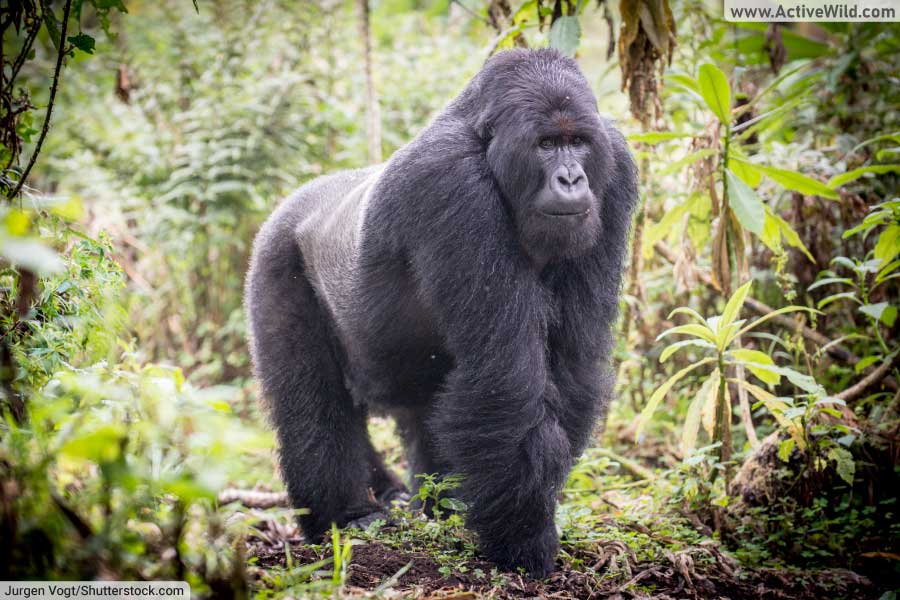
Scientific name: Gorilla beringei
Type of animal: Mammal
Family: Hominidae
Where found: Africa
Conservation status: Critically Endangered
The eastern gorilla is one of two living species of gorilla (the other being the western gorilla). The eastern gorilla is slightly larger than its western counterpart, making it the largest living primate. It has darker fur than the western gorilla.
There are two subspecies of eastern gorilla: the mountain gorilla (Gorilla beringei beringei) and the eastern lowland gorilla, or Grauer’s gorilla (Gorilla beringei graueri).
The mountain gorilla, whose hair is longer and thicker than that of the eastern lowland gorilla, is found in the mountain rainforests of Uganda, Rwanda and the Democratic Republic of Congo. Only around 1,000 mountain gorillas are left in the wild.
The eastern lowland gorilla is found only in the lowland tropical rainforests of the Democratic Republic of the Congo. The population of this subspecies currently stands at between 3,000 and 4,000 individuals.
The eastern gorilla is a critically endangered species. Illegal hunting for bushmeat is the principal threat to the species, with ongoing habitat loss also contributing to its decline.
Discover More With Active Wild
You can find out more about gorillas on this page: Gorilla Facts
Find out more about the mountain gorilla on this page: Mountain Gorilla Facts
You can find out more about primates on this page: Primates - The Ultimate Guide
Eastern Mole
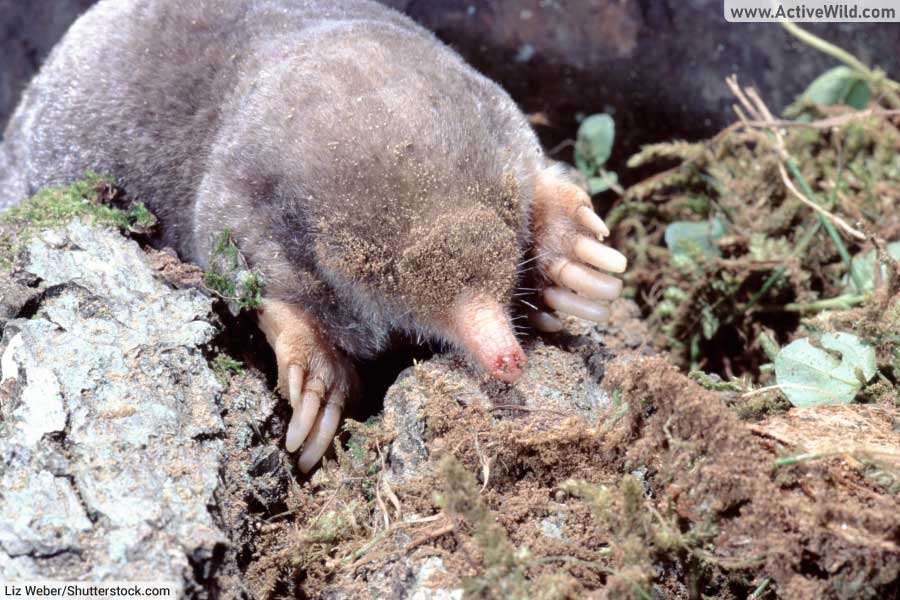
Scientific name: Scalopus aquaticus
Type of animal: Mammal
Family: Talpidae
Where found: North America
Conservation status: Least Concern
The eastern mole is a North American member of the mole family, Talpidae. The area in which it is found is larger than that of any other North American mole, covering the eastern United States and extending into Mexico and Canada.
The eastern mole prefers moist sandy or loamy soils to wet, clay-rich soils. Human-made environments such as golf courses provide an ideal habitat for the species!
Rarely seen above ground, the eastern mole has numerous adaptations for an underground, burrowing existence. Its eyelids are fused shut and only able to discern between light and dark; its snout is extremely sensitive (to make up for the lack of sight); and the hands of the forelimbs are large and equipped with powerful claws for digging.
Discover More With Active Wild
Discover more North American animals on this page: North American Animals List with Pictures & Facts
You can find out more about the different types of mammals on this page: Types of Mammals
Echidna
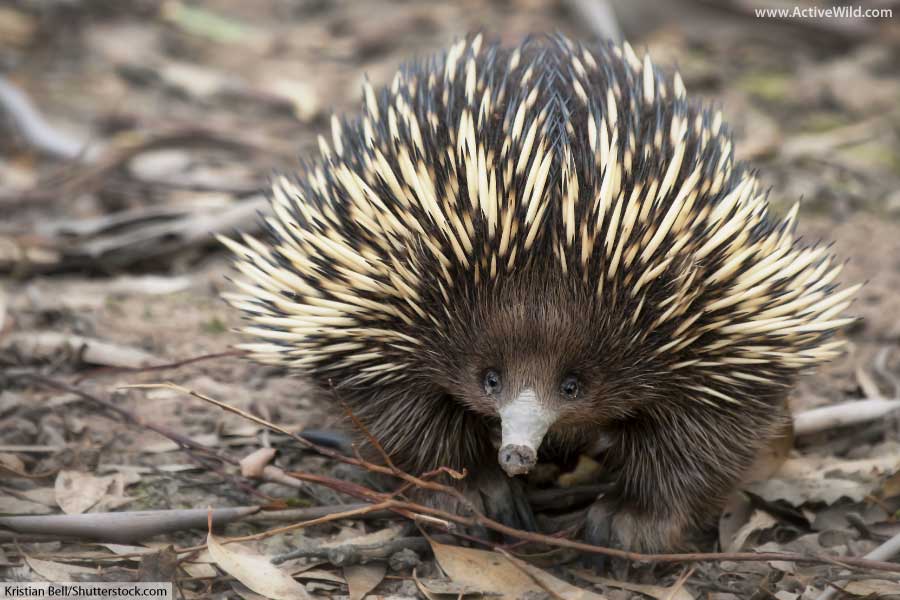
Type of animal: Mammal
Family: Tachyglossidae
Where found: Australia and New Guinea
Echidnas are spiny, ground-dwelling animals found in Australia and New Guinea.
The four species of echidna, along with the related platypus, are the only mammals that reproduce by laying eggs rather than by giving birth to live young.
This group of five species (the four echidnas and the platypus) form the order Monotremata. Members of this group are known as monotremes.
Due to their appearance and insect-based diet, echidnas are also known as “spiny anteaters”.
The four species of echidna, and the conservation status of each, are listed below:
- Short-beaked echidna Tachyglossus aculeatus Least Concern
- Western long-beaked echidna Zaglossus bruijnii Critically Endangered
- Eastern long-beaked echidna Zaglossus bartoni Vulnerable
- Sir David's long-beaked echidna Zaglossus attenboroughi Critically Endangered
The three long-beaked echidnas are found only in New Guinea. The short-beaked echidna is also found in Australia.
An echidna’s spines are adapted hairs. Although echidnas resemble porcupines and hedgehogs, they related to neither.
The short-beaked echidna mainly eats ants and termites, while the long-beaked echidnas feed mainly on worms and insect larvae. The long-beaked echidnas are larger than the short-beaked echidna, with body lengths ranging between 60 and 100 cm / 24 and 39 in.
Echidnas lack teeth, and are equipped with long, sticky tongues for gathering up their prey.
Discover More With Active Wild
You can find out more about echidnas on this page: Echidna Facts
Discover more Australian animals on this page: Australian Animals List with Pictures & Facts
Echinoderm

Phylum: Echinodermata
Where found: Oceans worldwide
Echinoderms are animals in the phylum Echinodermata. (A phylum is one of the widest animal groups, and may contain numerous classes, orders and families.)
There are over 11,000 echinoderm species, all of which are found in the sea (there are no freshwater or terrestrial echinoderms). Well known groups of echinoderms include starfish, sea urchins and sea cucumbers.
Echinoderms are remarkable in the way that they are able to regenerate (regrow) lost limbs and other body parts. Starfish will shed an arm or arms in self-defense, and over the space of several months to a year will re-grow the lost limbs.
The discarded limbs of some starfish are even able to grow into entirely new starfish!
Discover More With Active Wild
You can see examples of echinoderms on this page: Echinoderms Examples
You can see more ocean animals on this page: Ocean Animals List with Pictures & Facts
Discover more about the world’s oceans on this page: The Marine Biome
Edible Frog
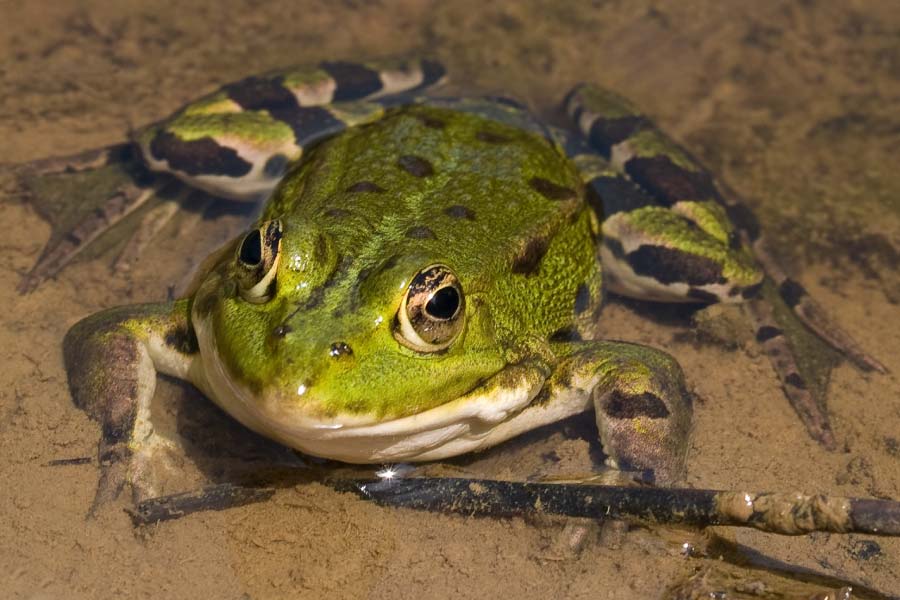
Scientific name: Pelophylax esculentus
Type of animal: Amphibian
Family: Ranidae
Where found: Europe
Conservation status: n/a
The edible frog is a member of the “true frog” family Ranidae. This common amphibian is found in lakes, ponds and other wetland habitats throughout much of Europe.
In France, the edible frog is used in the traditional “frog legs” dish. (The frog’s legs are said to taste like chicken.)
The edible frog is a hybrid of the pool frog and the marsh frog.
Discover More With Active Wild
You can find out more about amphibians on this page: Amphibians - The Ultimate Guide
Discover more European amphibians on this page: European Amphibians List with Pictures & Facts
Eel
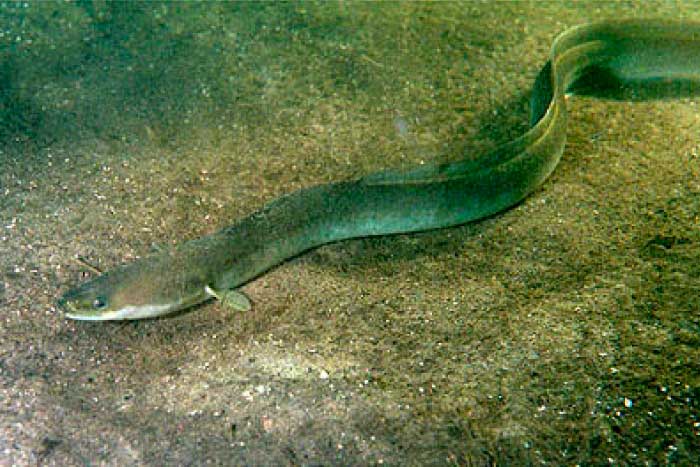
Type of animal: Fish
Order: Anguilliformes
Eels are fish of order Anguilliformes. There are around 918 species of eel, divided between 16 families.
Eels have long, snake-like bodies, with fins that run along almost the entire length of the upper and lower sides of their bodies.
Eels propel themselves through the water by moving their bodies in waves. They can also swim backwards in this manner.
Most of the 900+ species of eels are found in the sea, but the 19 species of eel that make up the family Anguillidae (the freshwater eels) migrate into freshwater habitats early on in their lives.
Freshwater eels may spend many years in freshwater rivers, lakes and ponds before returning to the sea to reproduce (and to die – the eels do not return to freshwater).
Discover More With Active Wild
You can see more ocean animals on this page: Ocean Animals List with Pictures & Facts
Discover more about the world’s oceans on this page: The Marine Biome
Eider (Common)
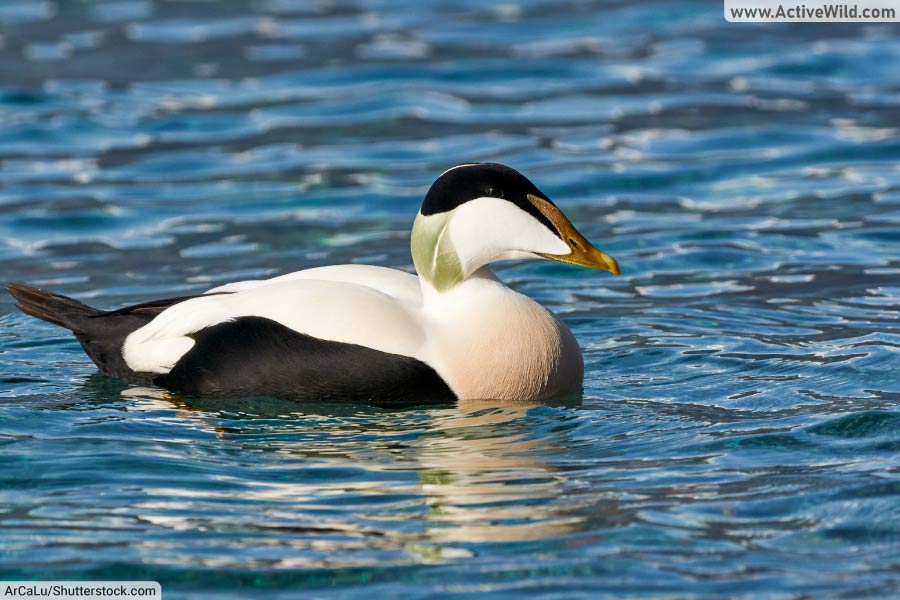
Scientific name: Somateria mollissima
Type of animal: Bird
Family: Anatidae
Where found: Europe, North America, Asia
Conservation status: Near Threatened
The common eider is a large sea duck found in northern Europe, North America and Siberia. It breeds in the Arctic.
The species is one of three eiders, which together make up the genus Somateria. (The other eiders are the king eider and spectacled eider.)
All eiders have dense down (a layer of fluffy feathers situated under the tough, external feathers) that provides a warm insulating layer against the cold.
Female eiders pluck their own down to line their nests. Eiderdown is collected by humans and used to make bedding and clothing.
Discover More With Active Wild
You can find out more about birds on this page: Birds - The Ultimate Guide
Discover different types of birds on this page: Types of Birds
Eland (Common)
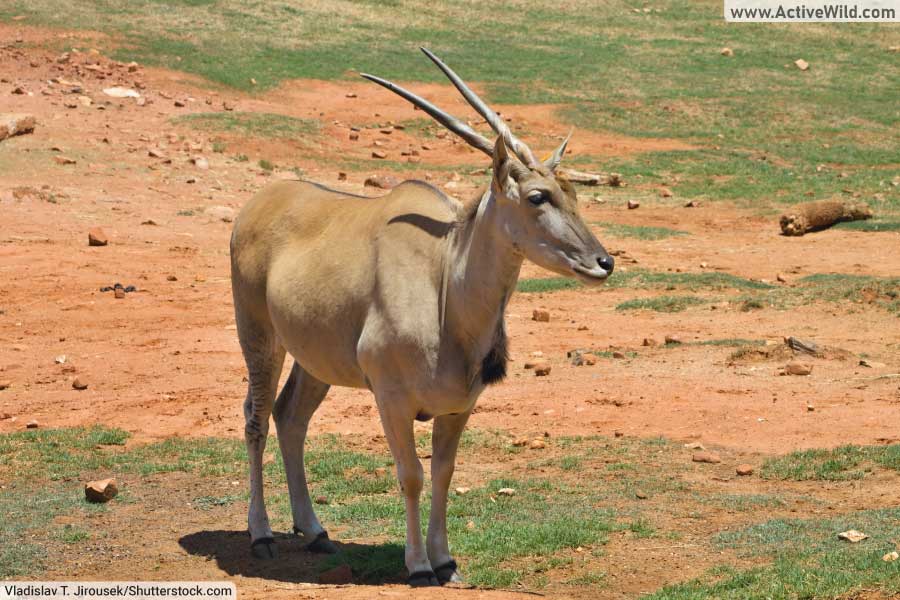
Scientific name: Taurotragus oryx
Type of animal: Mammal
Family: Bovidae
Where found: Africa
Conservation status: Least Concern
The common eland is a species of antelope found in southern and eastern Africa. It is found in grassland and savanna habitats, from Ethiopia and South Sudan south to South Africa.
The markings of common elands in the north of the species’ range are more pronounced than those of animals in the south.
The common eland is one of two eland species, the other being the giant eland, Taurotragus derbianus.
Elands are large antelopes with spiral horns. The giant eland and the common eland are the world’s largest, and second-largest antelopes, respectively.
A browsing animal, the common eland is known to cover extremely large distances and is found in a variety of grassland and woodland habitats.
Discover More With Active Wild
You can see more African animals on this page: African Animals List with Pictures & Facts
Discover more mammals on this page: List of Mammals with Pictures & Facts
Electric Eel
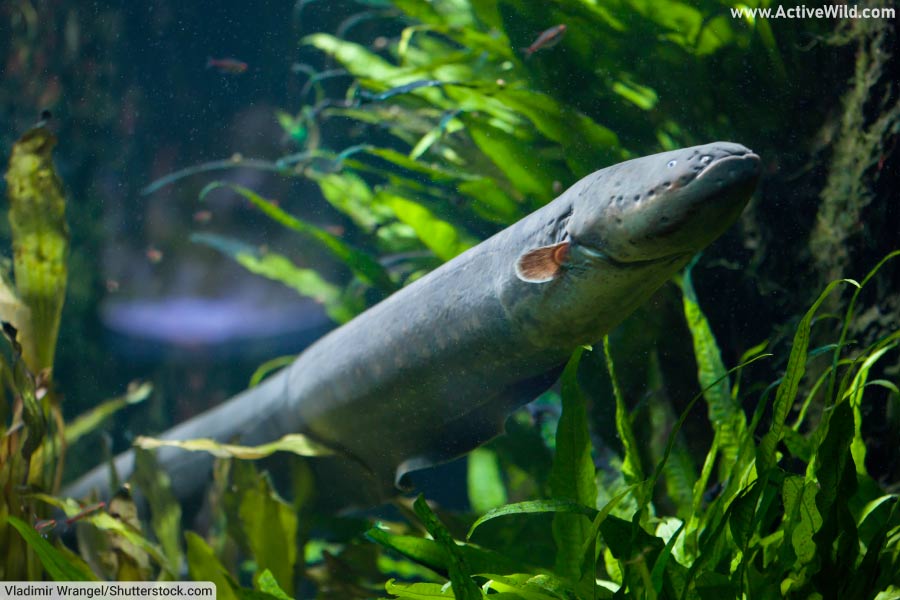
Scientific name: Electrophorus electricus
Type of animal: Fish
Family: Gymnotidae
Where found: South America
Conservation status: Least Concern
The electric eel is a species of fish well-known for its ability to create a strong (and potentially dangerous) electrical charge.
The electric eel is found in South America, where it inhabits freshwater rivers and swamps. It grows to around 2 m / 6.56 ft. in length.
Despite its name, the electric eel is a knifefish of order Gymnotiformes rather than a true eel of order Anguilliformes.
All knifefish are able to produce an electrical charge for navigating in dark, muddy water. However, the electrical charge produced by the electric eel is strong enough to be used both for capturing prey and as a means of self-defense.
Although an electric shock from an electric eel is extremely painful, it is rarely fatal.
Discover More With Active Wild
You can find out more about the electric eel on this page: Electric Eel Facts
Discover more rainforest animals on this page: Rainforest Animals List with Pictures & Facts
Eleonora’s Falcon

Scientific name: Falco eleonorae
Type of animal: Bird
Family: Falconidae
Where found: Europe, Africa
Conservation status: Least Concern
Eleonora's falcon is a mid-sized raptor (bird of prey). Like all falcons, it is a fast and agile flyer with long, tapered wings.
Midway in size between the larger peregrine falcon and the smaller hobby, Eleonora's falcon hunts large insects such as dragonflies, small birds and bats. Its captures its prey in its talons and transfers it to its beak in mid-flight.
In the summer, Eleonora's falcon is found on the Mediterranean coastlines of Europe and North Africa. The species migrates to Madagascar in the winter.
Falcons, despite being predatory birds, do not belong to the family Accipitridae, which is home to birds of prey such as hawks, eagles and harriers. Unlike the accipitrids, falcons dispatch their prey with their bills, rather than with their talons.
Discover More With Active Wild
You can find out more about birds on this page: Birds - The Ultimate Guide
Discover different types of birds on this page: Types of Birds
Elephant
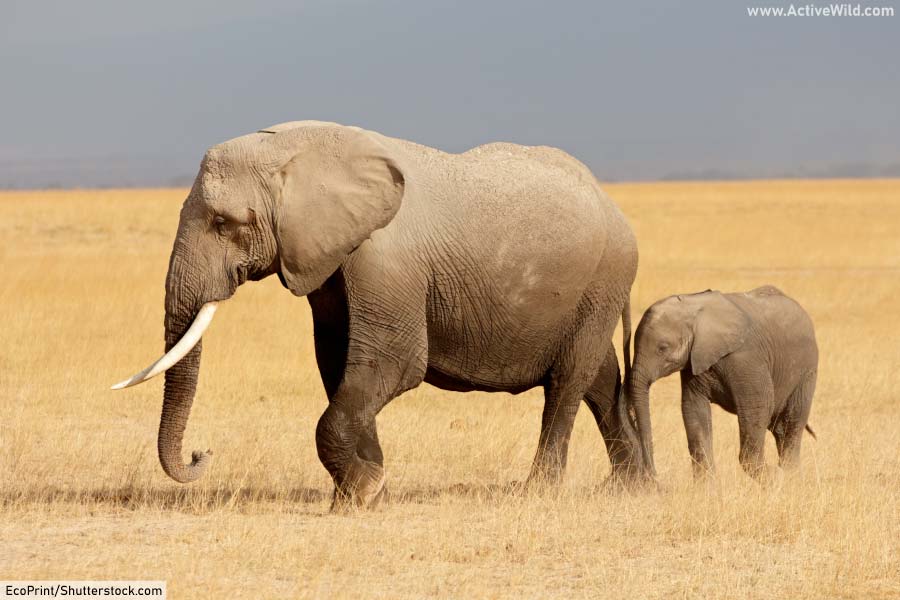
Type of animal: Mammal
Family: Elephantidae
Where found: Africa, Asia
No list of animals that start with E would be complete without the elephant! There are three species of elephant; from largest to smallest they are the: African bush elephant, Asian elephant, and African forest elephant.
The African bush elephant is the world’s largest land animal. It and the African forest elephant are found in Africa. As its name suggests, the Asian elephant is found in Asia.
The conservation status and scientific name of each elephant species is given below:
- African bush elephant Loxodonta Africana Endangered
- African forest elephant Loxodonta cyclotis Critically Endangered
- Asian elephant Elephas maximus Endangered
Both of the African elephants have large ears and deeply wrinkled skin. The Asian elephant has smaller ears and smoother skin than the African species. The skin of the Asian elephant can have a patchy appearance, unlike the plain grey of the African species.
The most distinctive feature of elephants is the trunk. The trunk is an extension of the elephant’s joined nose and upper lip. It is used to bring food and water to the elephant’s mouth, and to grasp and manipulate other objects.
Tusks, which are extended incisor teeth, are found on both male and female African elephants, but only on male Asian elephants. (Occasionally, female Asian elephants have very small tusks.)
An elephant’s tusks are used both as weapons and as tools for digging and moving objects.
Discover More With Active Wild
You can find out more about elephants on this page: Elephant Facts
Discover more about the African elephant on this page: African Elephant Facts
Discover more about the Indian elephant on this page: Indian Elephant Facts
Discover more about why elephants are endangered on this page: Endangered Elephants
Elephant Seal
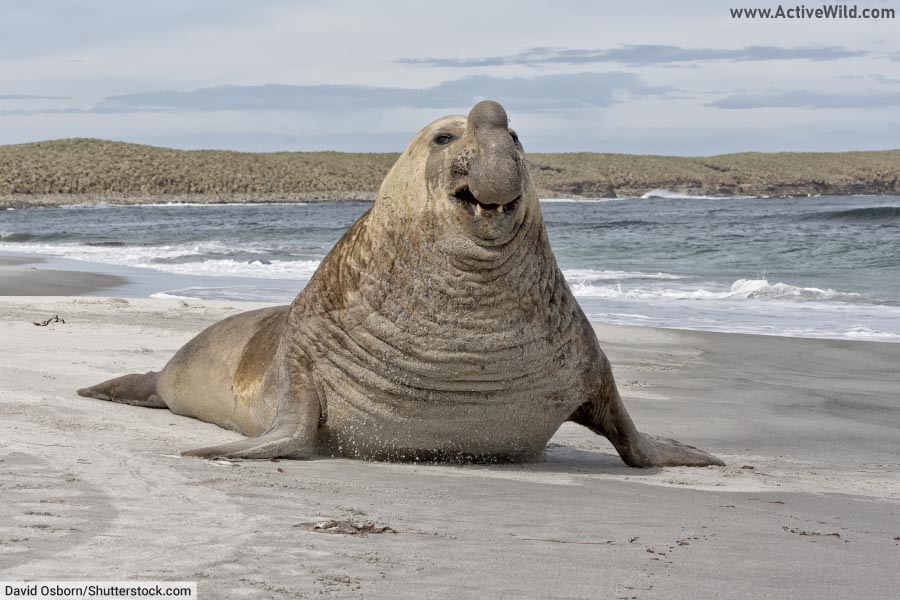
Type of animal: Mammal
Family: Phocidae
Where found: Pacific Ocean (northern elephant seal); Atlantic Ocean, Indian Ocean, Southern Ocean (southern elephant seal)
Conservation status: Least Concern
Elephant seals are the largest members of the earless seal family Phocidae. They are named for their extreme size and the long proboscis of the male (which resembles the trunk of an elephant).
There are two species of elephant seal: the northern elephant seal (Mirounga angustirostris) and the southern elephant seal (Mirounga leonina).
The northern elephant seal is found in the eastern Pacific Ocean in the northern hemisphere; the southern elephant seal in the South Atlantic, Indian Ocean and Southern Ocean in the southern hemisphere.
In both species of elephant seal, the male is several times larger than the female. This is an example of sexual dimorphism. (Sexual dimorphism is when the appearance of one sex is markedly different to that of the other.)
With a weight of up to 4,000 kg / 8,818.5 lb., the male southern elephant seal is up to 40% larger than the male northern elephant seal. It is the largest of all carnivorans, and the largest marine mammal that is not a whale.
Discover More With Active Wild
You can find out more about the southern elephant seal on this page: Southern Elephant Seal Facts
You can see more ugly animals on this page: Ugly Animals List with Pictures & Facts
See every seal found on Antarctica on this page: Antarctic Seals List with Pictures & Facts
Discover more Antarctic animals on this page: Antarctic Animals List with Pictures & Facts
Elephant Shrew

Type of animal: Mammal
Family: Macroscelididae
Where found: Africa
There are fifteen species of elephant shrews, all of which are found in southern Africa. Together they make up the family Macroscelididae. Elephant shrews are also known as jumping shrews or sengis.
Elephant shrews are mouse or rat-sized animals, named for their shrew-like appearance and extended proboscises (noses).
Despite the name, elephant shrews are not related to shrews. In fact, they belong to a group of animals known as Afrotheria, which includes other animals that originated in Africa, such as golden moles, tenrecs, elephants and sea cows.
This means that elephant shrews are actually more closely related to elephants than they are to shrews!
Elephant shrews use their long noses to locate their prey, which consists of small invertebrates such as insects, spiders, earthworms.
Discover More With Active Wild
You can see more African animals on this page: African Animals List with Pictures & Facts
Discover more mammals on this page: List of Mammals with Pictures & Facts
Elk
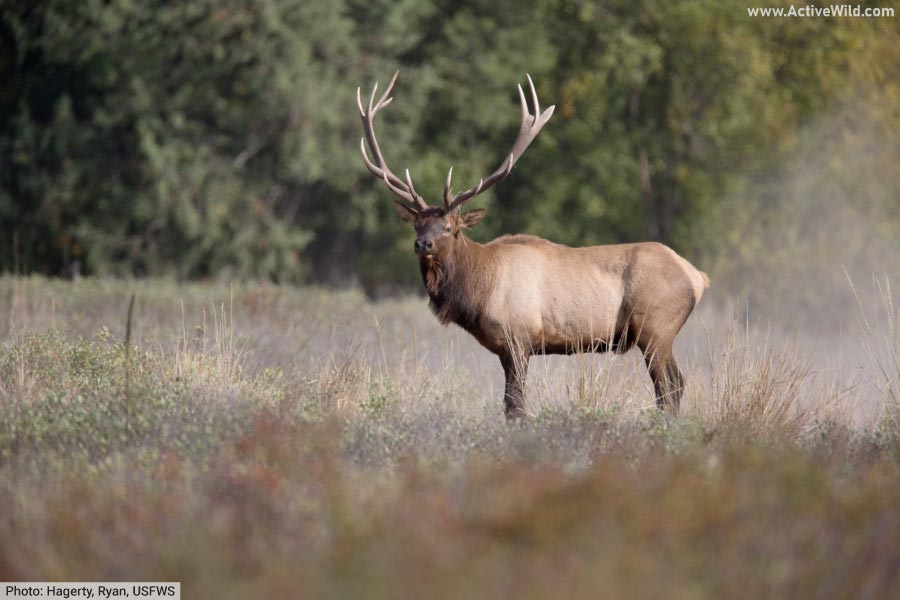
Scientific name: Cervus canadensis
Type of animal: Mammal
Family: Cervidae
Where found: North America, Asia
Conservation status: Least Concern
The elk is the second largest species of deer in the world, although the sambar, which is found in Asia, can reach a similar size (the world’s largest deer is the moose).
The elk is found in the United States and Canada in North America, and in China, Mongolia, Russia, and several other Central and Eastern Asian countries.
The species is usually found in mountainous regions, moving between higher slopes during the summer and valleys during the winter. It lives in a variety of habitats, including woodlands, forests and grasslands.
Like all cervids (members of the deer family, Cervidae), the elk is herbivorous. Male elk grow impressive antlers, which are shed each year in the winter.
Discover More With Active Wild
You can see more animals with antlers on this page: Animals With Antlers
Discover more amazing North American animals on this page: North American Animals – Pictures & Facts
Discover more about mammals on this page: Mammals – The Ultimate Guide
Emperor Penguin

Scientific name: Aptenodytes forsteri
Type of animal: Bird
Family: Spheniscidae
Where found: Antarctica
Conservation status: Near Threatened
The emperor penguin is the largest species of penguin both by weight and by height, and the sixth-largest of all living birds by weight. An adult emperor penguin stands around 1m / 3.28 ft. tall, and weighs up to 45 kg / 99 lb.
The emperor penguin is found in Antarctica, and is the only penguin species that breeds on the continent during the winter. Male emperor penguins incubate their eggs single-handedly for two bitterly cold months, standing huddled together in large groups for warmth.
The emperor penguin makes up for not being able to fly by being the world’s deepest-diving bird. It uses its small, but powerful wings to “fly” through the water.
Discover More With Active Wild
You can see every species of penguin on this page: Types Of Penguins - Pictures & Facts
You can find out more about birds on this page: Birds - The Ultimate Guide
Discover different types of birds on this page: Types of Birds
Emu
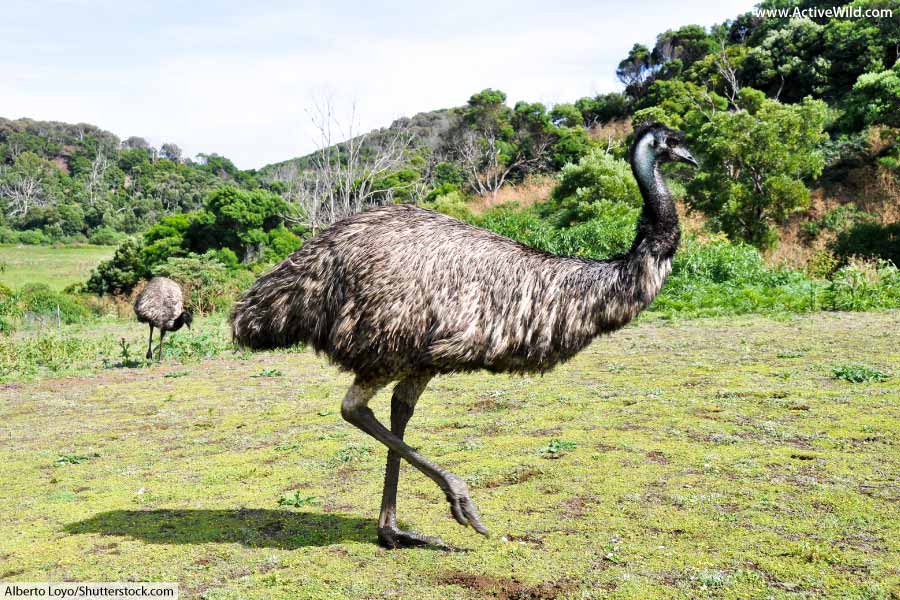
Scientific name: Dromaius novaehollandiae
Type of animal: Bird
Family: Casuariidae
Where found: Australia
Conservation status: Least Concern
The emu is a large, flightless bird found only in Australia.
Standing up to 1.9 meters / 6.2 ft in height, the emu is the world’s third-tallest bird species (the common and Somali ostriches are the tallest and second-tallest, respectively). It is the fifth-heaviest species of bird, after the two ostriches and the southern and northern cassowaries.
The emu is found in savanna, shrubland and grassland habitats. An omnivore, the emu eats plants and invertebrates such as insects, spiders and millipedes. It also swallows small stones to aid digestion.
Although extinct in Tasmania, the emu is found across much of mainland Australia and is not currently threatened.
Discover More With Active Wild
You can find out more about birds on this page: Birds - The Ultimate Guide
Discover different types of birds on this page: Types of Birds
Discover more Australian animals on this page: Australian Animals List with Pictures & Facts
English Shepherd

Scientific name: Canis familiaris / Canis lupus familiaris
Type of animal: Mammal
Family: Canidae
Conservation status: Domestic
The English shepherd is a breed of working dog originally bred for herding livestock. It is an American breed whose origins lie in collies brought to America by British farmers.
An English shepherd’s coat is typically either black and white; black and tan; black, white and tan; sable and white, or tan & white.
English shepherds are extremely intelligent and energetic dogs. They need a high amount of mental stimulus and physical exercise, but in return are hard-working and loyal.
Discover More With Active Wild
You can find out more about dogs on this page: Dog Facts
You can see every dog species on this page: Dog Species List with Pictures & Facts
Eskimo Dog

Scientific name: Canis familiaris / Canis lupus familiaris
Type of animal: Mammal
Family: Canidae
Conservation status: Domestic
The Eskimo dog, or American Eskimo dog, is a small to medium-small breed of dog that stems from the German spitz. Its coat is long and fluffy, and typically white, although a white and biscuit color variation is also recognized. It carries its thick, fluffy tail over its back.
The Eskimo dog is an active, obedient breed that is good with kids. As a bonus it has a “happy” face and always seems to be smiling!
Discover More With Active Wild
You can find out more about dogs on this page: Dog Facts
You can see every dog species on this page: Dog Species List with Pictures & Facts
Ethiopian Wolf

Scientific name: Canis simensis
Type of animal: Mammal
Family: Canidae
Where found: Africa
Conservation status: Endangered
The Ethiopian wolf is a member of the dog family Canidae endemic to (only found in) Ethiopia. Coyote-sized, the Ethiopian wolf has long legs and a red-brown coat, with white patches on the chin, chest, undersides, legs and tail.
The Ethiopian wolf lives in packs of three to thirteen individuals. The wolf is most active during the day; during the night it rests with the pack in the open.
Despite being a pack animal, the Ethiopian wolf usually hunts alone. It mainly targets small prey, in particular the big-headed mole rat and common grass rat. Occasionally, the species hunts in groups and brings down larger prey such as mountain nyala calves.
Much of the Ethiopian wolf’s natural habitat has been converted into farmland, and it is habitat loss that is the main cause of the species’ Endangered status.
The Ethiopian wolf is one of the world’s rarest canids, with an estimated population numbering fewer than 200 adult individuals.
Discover More With Active Wild
You can see more African animals on this page: African Animals List with Pictures & Facts
You can see every dog species on this page: Dog Species List with Pictures & Facts
Eurasian Beaver

Scientific name: Castor fiber
Type of animal: Mammal
Family: Castoridae
Where found: Europe, Asia
Conservation status: Least Concern
With a body length of up to 1m / 3.28 ft., and a maximum weight of around 30 kg / 66 lb., the Eurasian beaver is the largest rodent found in Eurasia (the landmass that incorporates both Europe and Asia).
The Eurasian beaver is one of two beaver species, the other being the North American beaver.
The Eurasian beaver is slightly larger than its North American counterpart. Other differences include a slightly larger head and narrower, less oval tail. The two species are unable to produce offspring together.
The Eurasian beaver is found from France eastwards into Russia and China. It is also present in Scandinavia and has been re-introduced into the UK after becoming extinct there in the 16th Century.
The dams made by the Eurasian beaver create ecosystems that support a wide range of other species. For this reason the Eurasian beaver is regarded as being a “keystone species” – a species whose presence has a disproportionally large effect on its environment.
Discover More With Active Wild
You can find out more about the North American beaver on this page: North American Beaver Facts
You can find out more about rodents on this page: Rodents – The Ultimate Guide
Discover more about mammals on this page: Mammals – The Ultimate Guide
Eurasian Red Squirrel

Scientific name: Sciurus vulgaris
Type of animal: Mammal
Family: Sciuridae
Where found: Europe, Asia
Conservation status: Least Concern
Known simply as the “red squirrel” outside of North America, the Eurasian red squirrel is a mid-sized rodent in the squirrel family, Sciuridae.
The Eurasian red squirrel is a different species to the American red squirrel (Tamiasciurus hudsonicus), which is known as the “red squirrel” in its native North America.
With its chestnut-red fur, bushy tail and tufted ears, the Eurasian red squirrel is a familiar sight in forests and woodlands throughout much of Europe and northern Asia.
The Eurasian red squirrel eats seeds and nuts. It gnaws pinecones to get at the nuts within, and the emptied-out, apple-core shaped pinecone husks discarded by the squirrel are a sign of the species’ presence.
The squirrel builds nests, which are known as “dreys”, out of twigs, leaves and bark.
The introduction of the grey squirrel from North America into some areas of Europe (notably the UK) has led to the Eurasian red squirrel’s decline in those regions.
Discover More With Active Wild
You can find out more about rodents on this page: Rodents – The Ultimate Guide
Discover more about mammals on this page: Mammals – The Ultimate Guide
Eurasian Wolf
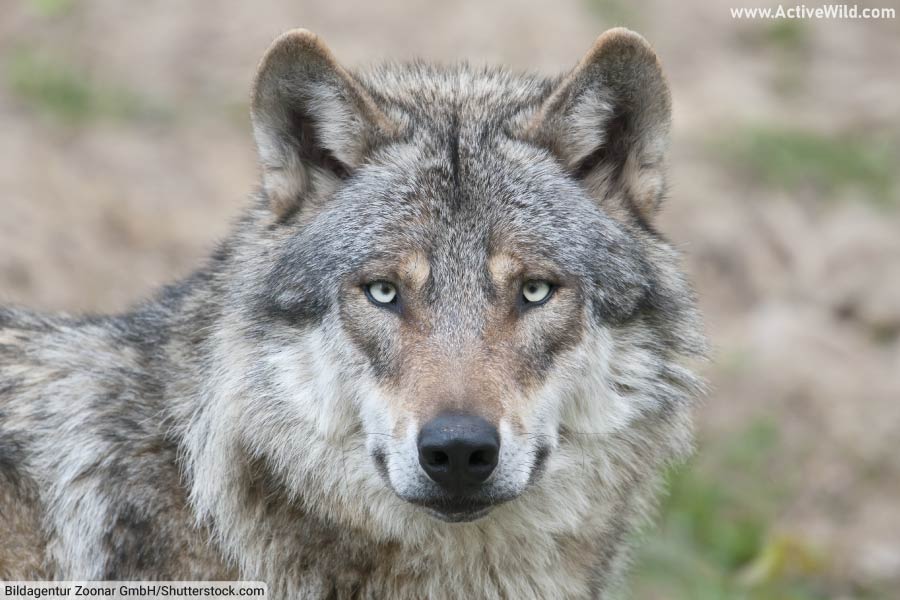
Scientific name: Canis lupus lupus
Type of animal: Mammal
Family: Canidae
Where found: Europe, North Asia
Conservation status: Least Concern
The Eurasian wolf is one of 38 recognized subspecies of gray wolf.
(A subspecies is a distinct population of a species whose distinguishing characteristics aren’t large enough to warrant their being treated as a separate species.)
Other gray wolf subspecies include the Arabian wolf, Mongolian wolf, Arctic wolf and eastern wolf.)
All 38 wolf subspecies are the same species (Canis lupus); the Eurasian wolf could have pups with any of the other grey wolf subspecies.
The Eurasian wolf is one of the largest wolf subspecies, and the largest wolf subspecies found outside of the Americas. It is found from Spain to eastern Russia, although its distribution in western Europe is patchy.
Discover More With Active Wild
You can find out more about the Eurasian wolf on this page: Eurasian Wolf Facts
Find out more about wolves on this page: Wolf Facts
You can see every dog species on this page: Dog Species List with Pictures & Facts
Discover more about mammals on this page: Mammals – The Ultimate Guide
European Common Frog
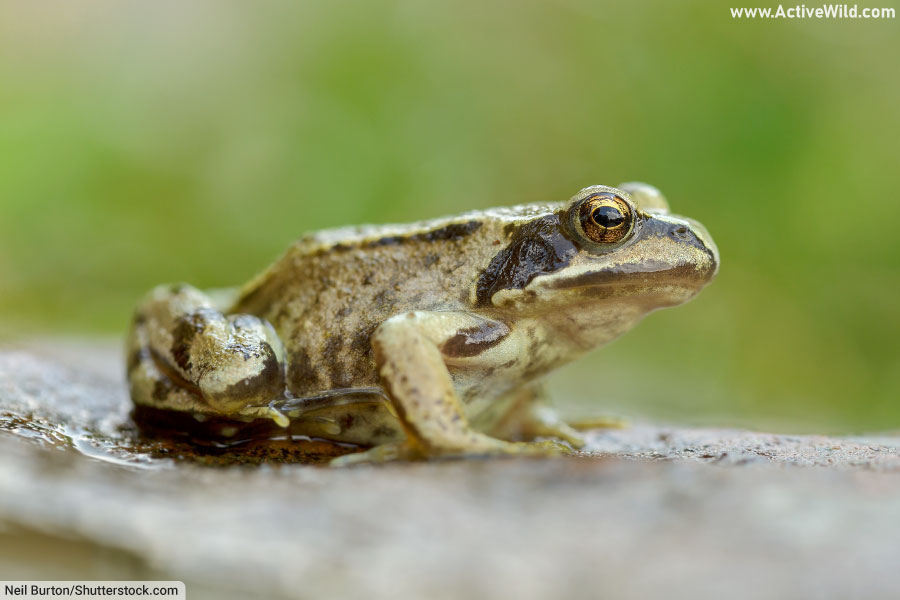
Scientific name: Rana temporaria
Type of animal: Amphibian
Family: Ranidae
Where found: Europe, Asia
Conservation status: Least Concern
The European common frog, also known as the common frog, is found throughout much of Europe and Asia. It is a mid-sized frog with a body length of 6 to 9 cm (2.4 to 3.5 in.).
The species is typically olive-green to light brown, but its color varies in depending on its location and habitat.
Like most frogs, the common frog hatches from eggs laid in jelly-like clumps called “frogspawn”. It spends the first part of its life in the water in a larval stage known as a “tadpole”. It then undergoes metamorphosis, losing its tail and developing lungs and limbs, allowing it to leave the water and live on land.
Discover More With Active Wild
You can find out more about the common frog on this page: Common Frog Facts
You can find out more about amphibians on this page: Amphibians - The Ultimate Guide
Discover more European amphibians on this page: European Amphibians List with Pictures & Facts
European Grass Snake
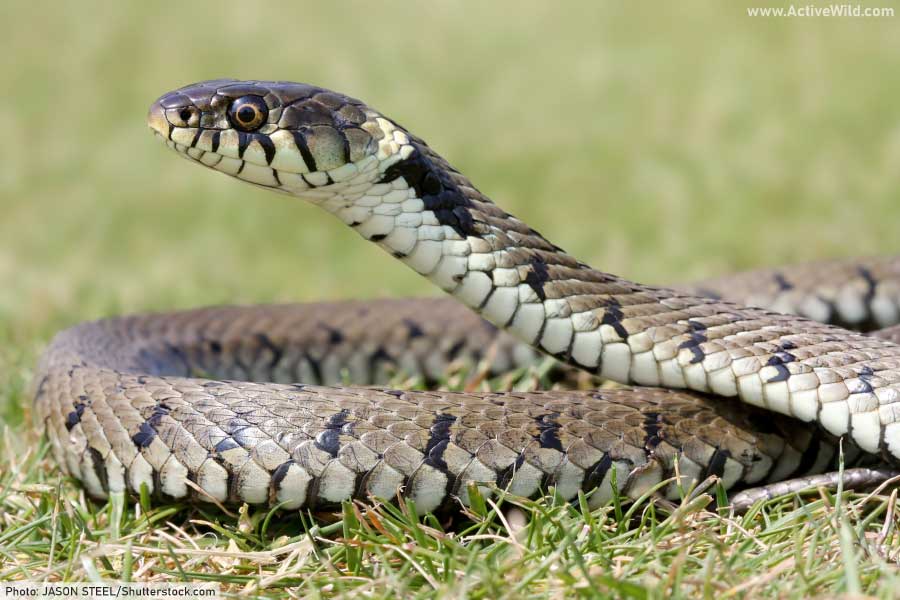
Scientific name: Natrix natrix
Type of animal: Reptile
Family: Colubridae
Where found: Europe, Asia
Conservation status: Least Concern
The European grass snake is a non-venomous snake found throughout much of Europe. The species is a strong swimmer and often found near water in forests, woodlands, grasslands, scrublands and wetlands.
Amphibians are the main prey of the European grass snake, but the species will also eat fish, young birds and small mammals.
This relatively common snake is typically dark olive-green in color, but its color can be darker or lighter depending upon the region in which it is found.
The European grass snake has a distinctive pale yellow collar behind its head. It can grow well over 1 m / 3.28 ft. in length, but is typically much smaller.
The barred grass snake Natrix Helvetica, a closely-related species found in Britain, was once considered to be a subspecies of grass snake, but since 2017 has been treated as a separate species.
Discover More With Active Wild
You can find out more about reptiles on this page: Reptiles - The Ultimate Guide
Discover more about snakes on this page: Snake Facts
Discover more types of snakes on this page: Types of Snakes with Pictures & Facts
Animals That Start With E: Conclusion
We hope that you’ve discovered some interesting animals with names beginning with E on this page.
You can discover more animals in our A to Z animals section by clicking on the letters below…






























That will really help me when playing family games!
There’s emperor penguin but I don’t see an emperor scorpion.